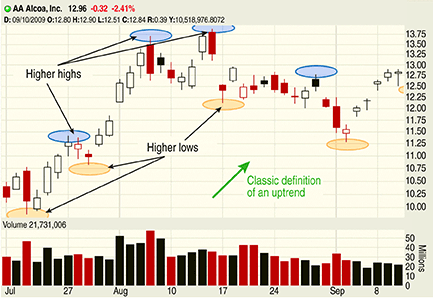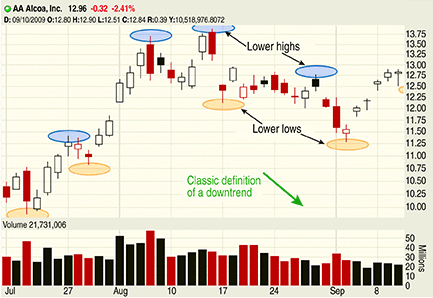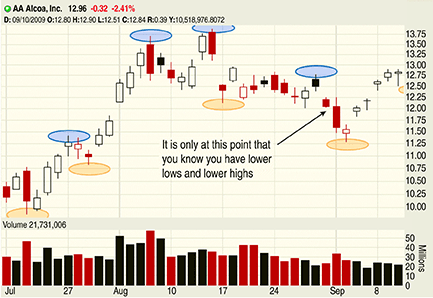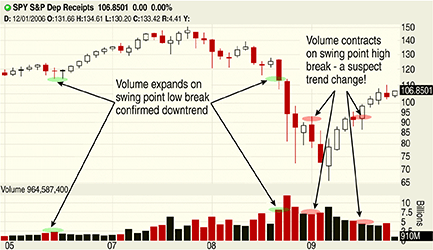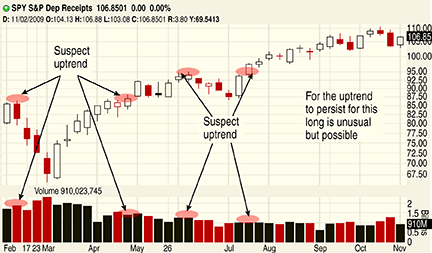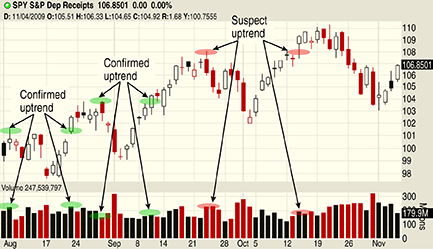
HOT TOPICS LIST
- Strategies
- Stocks
- Buy
- Investing
- Brokers
- Psychology
- Interviews
- Accumulate
- Sell
- Hold
- Spotlight
- Websites
- Candlestick Corner
- Gold & Metals
- Options Trading
LIST OF TOPICS
THE CHARTIST
Suspect Trends
11/23/09 12:47:29 PM PSTby L.A. Little
Do you get the feeling that the trend is changing? Here's how to confirm or deny that suspicion.
| Robert Edwards and John Magee first published their Technical Analysis Of Stock Trends in 1948. In technical trading circles, this book has come to be known as the bible of technical analysis. It is perhaps the most definitive book on pure technical analysis, as it pertains to strictly reading chart patterns. In their classic work, Edwards and Magee define trends. Their definition of trend is the classical definition (that is, the tendency or proclivity for the price to move in a straight line), but for my work, their definition is insufficient. As a result, I have expanded upon it with the concept of suspect and confirmed trends. Let me explain. TRADING WITH THE TREND
FIGURE 1: THE CLASSIC UPTREND. An uptrend is defined as a series of higher highs and higher lows based on price. On the lefthand side of this chart, you see a series of higher highs and higher lows which, according to the classical definition, is an uptrend.
In this chart, you see on the lefthand side of the chart a series of higher highs and higher lows -- an uptrend according to the classical definition of trend. In Figure 2 you see the same chart with the downtrend called out. You can easily see a series of lower lows and lower highs.
FIGURE 2: THE CLASSIC DOWNTREND. Here you can easily see a series of lower lows and lower highs. |
| Given the generally accepted technical analysis notion that you want to trade in the direction of the prevailing trend, you would want to be long while the trend is higher and short when it is lower. Simple enough, right? Not quite. Assume you were long AA from the $10 area. When should you exit the trade? Looking at the chart and using the classic definition of a trend, when would you take all or partial profits? Unfortunately, with the classic definition, you would be unaware that the trend had changed until you witnessed a series of lower highs and lower lows. Now look at Figure 3. You would not know until you had a break of the previous swing low. That break occurs when AA trades to $12. If you used this signal to exit, you would be exiting at exactly the wrong time -- when the trend was about to turn and become bullish again.
FIGURE 3: A CLASSIC TREND CHANGE. Based on the classic definition of a trend, you would be unaware that the trend had changed until you witnessed a series of lower highs and lower lows. This takes place when AA trades at $12. If you used this signal to exit, you would be exiting at the wrong time -- that is, when the trend is about to turn and become bullish again.
THE NOTION OF SUSPICION
Using this method, the market provides you with an early warning system regarding the quality of the trend. Look again at the AA chart (Figure 4) using this enhanced definition of trend. |
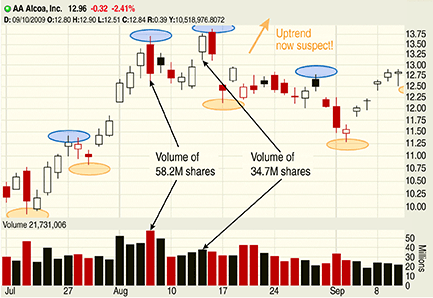 FIGURE 4: A SUSPECT UPTREND. When AA traded over the previous swing point, it was quite clear that volume contracted. When that happens, the uptrend becomes suspect. That is your early warning sign.
Using this enhanced definition, when AA traded over the previous swing point, it was clear that volume contracted. When that happens, the uptrend becomes suspect. That is your early warning sign. That is the signal that you should take action. Remember, however, a suspect trend does not mean that the trend is guaranteed to fail; it only provides an early warning system that something is awry. It is a warning, a heads-up that you probably need to take action. That action could be to liquidate the position or to hedge it, or even to practice some basic money management principles such as taking partial profits. What you do depends on your time frame, your average entry price point, and so on. ALL MARKETS AND ALL TIME FRAMES
FIGURE 5: A LONG-TERM TIME FRAME. The SPY ETF signaled that a downtrend was confirmed in September 2008. That was a warning sign and it didn't take long for the warning to turn into a full-fledged bear market. Note how the current trend change is suspect. As prices traded over and closed higher than the previous swing point from January 2009, the change in trend was not confirmed but is instead suspect. |
| On a long-term time frame, the SPY ETF signaled that a downtrend was confirmed in September 2008. That was a warning sign and it didn't take long for the warning to turn into a full-fledged bear market. Note how the current trend change is suspect. As prices traded over and closed higher than the previous swing point from January 2009, the change in trend was not confirmed but is instead suspect. On an intermediate-term time frame, we see the same sort of chart behavior -- suspect trends (Figure 6). Again, on this time frame, warnings are being issued. This has occurred since May 2009 and so far it hasn't mattered. It will, though, and prices will likely retrace to this area where suspicion began -- eventually.
FIGURE 6: AN INTERMEDIATE-TERM TIME FRAME. Again, on the weekly chart, warnings are being issued. This has occurred since May 2009 and prices are likely to retrace to this area where suspicion began.
Turning to the short-term time frame (Figure 7), we can see how these suspect trends have persisted. On the shortest time frame, the market has continued to confirm the uptrend, which is why it has continued to climb higher. Only on this last swing point (high) break has the trend turned suspect. That can be corrected if volume were to surge and take out the next higher swing point that exists, but given the long- and intermediate-term time frames, that is unlikely. More likely is that this market finally begins to trade lower and correct the many nonconfirmation points that have occurred on the longer time frame.
FIGURE 7: A SHORT-TERM TIME FRAME. These suspect trends have persisted. On the daily chart, the market has continued to confirm the uptrend, which is why it has continued to climb higher. Only on this last swing point (high) break has the trend turned suspect. |
| ENHANCED SWING POINT In your trading, it is important to have guideposts --something to help when wading through the trading waters. The concept of confirmed and suspicious trends, as viewed through the enhanced definition of trend, provides such a guiding light. As with anything in trading, it isn't failproof. It is, however, a notable improvement in the classic definition of a trend and, when combined with wise money management, it can increase your odds of success.
SUGGESTED READING |
L.A. Little is an author, professional trader, and money manager who writes for www.tatoday.com.
PRINT THIS ARTICLE

Request Information From Our Sponsors
- VectorVest, Inc.
- Executive Premier Workshop
- One-Day Options Course
- OptionsPro
- Retirement Income Workshop
- Sure-Fire Trading Systems (VectorVest, Inc.)
- Trading as a Business Workshop
- VectorVest 7 EOD
- VectorVest 7 RealTime/IntraDay
- VectorVest AutoTester
- VectorVest Educational Services
- VectorVest OnLine
- VectorVest Options Analyzer
- VectorVest ProGraphics v6.0
- VectorVest ProTrader 7
- VectorVest RealTime Derby Tool
- VectorVest Simulator
- VectorVest Variator
- VectorVest Watchdog
- StockCharts.com, Inc.
- Candle Patterns
- Candlestick Charting Explained
- Intermarket Technical Analysis
- John Murphy on Chart Analysis
- John Murphy's Chart Pattern Recognition
- John Murphy's Market Message
- MurphyExplainsMarketAnalysis-Intermarket Analysis
- MurphyExplainsMarketAnalysis-Visual Analysis
- StockCharts.com
- Technical Analysis of the Financial Markets
- The Visual Investor

